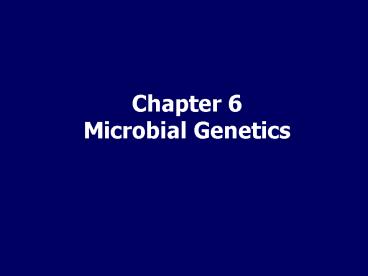Chapter 6 Microbial Genetics PowerPoint PPT Presentation
1 / 32
Title: Chapter 6 Microbial Genetics
1
Chapter 6Microbial Genetics
2
Structure and Function of Genetic Materials
- DNA RNA
- DNAdeoxyribonucleic acid
- RNAribonucleic acid
- Basic building blocks
- Nucleotides
- Phosphate group
- Pentose sugar
- Nitrogenous base
3
Structure of DNA
- Double stranded (double helix)
- Chains of nucleotides
- 5 to 3 (strands are anti-parallel)
- Complimentary base pairing
- A-T
- G-C
4
DNA Structure
Phosphate-P Sugar-blue Bases-ATGC
5
DNA Replication
- Bacteria have closed, circular DNA
- Genome genetic material in an organism
- E. coli
- 4 million base pairs
- 1 mm long (over 1000 times larger that actual
bacterial cell. How it can be put into a cell? - DNA takes up around 10 of cell volume
6
DNA Replication occurs at the replication fork
- 5 to 3
- DNA helicase-unzips parental DNA strand that is
used as a template - Leading stand (5 to 3-continuous)
- DNA polymerase-joins growing DNA strand after
nucleotides are aligned (complimentary) - Lagging strand (5 to 3-not continuous)
- RNA polymerase (makes short RNA primer)
- DNA polymerase (extends RNA primer then digests
RNA primer and replaces it with DNA) - DNA ligase (seals Okazaki fragments-the newly
formed DNA fragments)
7
Replication Fork
1
8
Protein Synthesis
- DNA-------? mRNA------? protein
- transcription translation
- Central Dogma(????)
- of Molecular Genetics
9
Transcription
- One strand of DNA used as a template to make a
complimentary strand of mRNA - Promoter/RNA polymerase/termination site/5 to 3
- Ways in which RNA DNA differ
- RNA is ss
- RNA sugar is ribose
- Base pairing-A-U
10
The structure of a bacterial gene
I. Single gene transcript
Translational end
Transcription start site
Coding sequence
TAA
ATG
hisG
transcript
Transcriptional terminator
Ribosome binding site/ translational start (ATG)
Promoter
11
Multigene bacterial operon
Translational end
Transcription start site
ATG
TAA
TAA
hisG
hisH
transcript
-One promoter, one transcriptional stop multiple
translational starts and stops
12
Transcription
13
Types of RNA
- Three types
- mRNA messenger RNA
- Contains 3 bases ( codon)
- rRNA ribosomal RNA
- Comprises the 70 S ribosome
- tRNA transfer RNA
- Transfers amino acids to ribosomes for protein
synthesis - Contains the anticodon (3 base sequence that is
complimentary to codon on mRNA)
14
Genetic Code
- DNA triplet code
- mRNA codon (complimentary to triplet code of
DNA) - tRNA anticodon (complimentary to codon)
15
Genetic Code
- Codons code for the production of a specific
amino acid - 20 amino acids
- 3 base code
- Degenerative more than 1 codon codes for an
amino acid - Universal in all living organisms
16
Genetic Code
17
Translation
- Three parts
- Initiation-start codon (AUG)
- Elongation-ribosome moves along mRNA
- Termination stop codon reached/polypeptide
released and new protein forms - rRNAsubunits that form the 70 S ribosomes
(protein synthesis occurs here) - tRNAtransfers amino acids to ribosomes for
protein synthesis)
18
Translation
19
Translation
20
Translation
21
Translation
22
Mutations
- Changes in base sequence of DNA/lethal and
inheritable - Can be
- Harmful
- Lethal
- Helpful
- Silent
23
Normal DNA/Missense Mutation
24
Nonsense Mutation/Frameshift Mutation
25
Genetic Transfer in Bacteria
- Genetic transfer results in genetic variation
- Genetic variation is needed for evolution
- Three ways
- Transformation genes transferred from one
bacterium to another as naked DNA - Conjugation plasmids transferred 1 bacteria to
another via a pilus - Transduction DNA transferred from 1 bacteria to
another by a virus
26
Transduction by a bacteriophage
27
Generalized Transduction
- Infection of Donor
- Phage replication and degradation of host DNA
- Assembly of phages particles
- Release of phage
- Infection of recipient
- Homologous recombination
Potentially any donor gene can be transferred
28
Transformation
- Steps
- Uptake of DNA
- Gram
- Gram -
- Recombination
- Legitimate, homologous or general
- recA, recB and recC genes
- Significance
- Phase variation in Neiseseria
- Recombinant DNA technology
29
Transformation
30
Conjugation in E. coli
31
Conjugation continued
32
Conjugation continued

